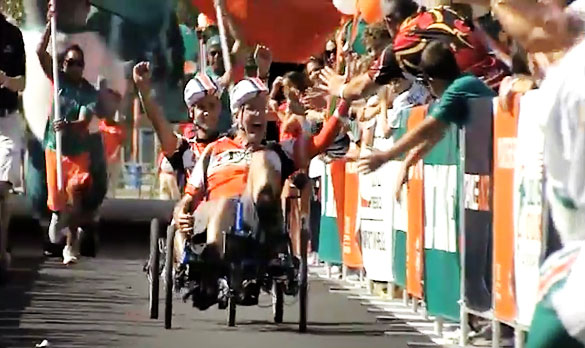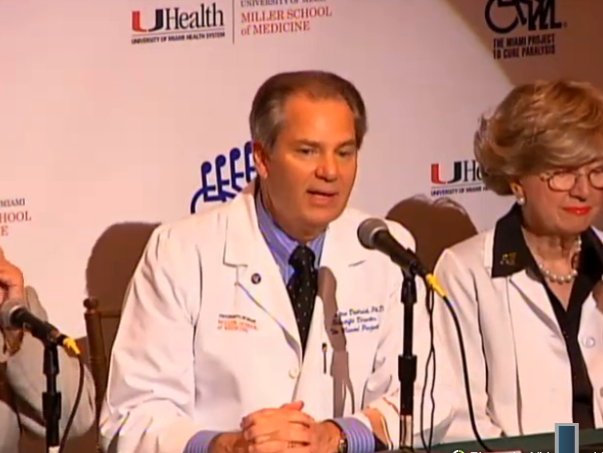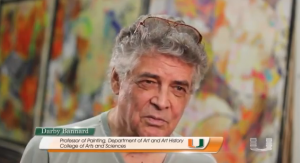GoMRI’s stated goals include improving the “fundamental understanding of the dynamics of such events and their environmental stresses and public health implications.”
Made up of 26 principal investigators, half from UM and the other half from 11 national and international universities and research institutions, the CARTHE team investigates where and how fast pollutants travel in the ocean. Inaugural fieldwork included this summer’s Grand Lagrangian Deployment (GLAD), which released an unprecedented 300 custom-made buoys known as “drifters” from the University of Miami’s R/V F. G. Walton Smith in the Gulf of Mexico. This experiment, the largest of its kind ever attempted, provided a once-in-a-lifetime opportunity to collect valuable data as Hurricane Isaac crossed over the GLAD instruments, which measure oceanographic currents, winds, and meteorological conditions. A key resource is CARTHE’s newly acquired global supercomputer, the Cray XE6m, which is housed at the Rosenstiel School.
Data collected will help to shed light on how pollutants may behave in normal and hurricane weather events. “Understanding the various scales of oceanic currents and flows lies at the very heart of being able to improve our understanding and prediction of oil spills,” says özgökmen. CARTHE shares data with the U.S. Coast Guard to assist its search and rescue operations.
Rosenstiel School professor Tamay Özgökmen is director of the Consortium for Advanced Research on Transport of Hydrocarbon in the Environment (CARTHE). “The task ahead is the oceanographic equivalent of the moon mission—an important and challenging scientific problem with immediate social impact,” he says.
Made up of 26 principal investigators, half from UM and the other half from 11 national and international universities and research institutions, the CARTHE team investigates where and how fast pollutants travel in the ocean. Inaugural fieldwork included this summer’s Grand Lagrangian Deployment (GLAD), which released an unprecedented 300 custom-made buoys known as “drifters” from the University of Miami’s R/V F. G. Walton Smith in the Gulf of Mexico. This experiment, the largest of its kind ever attempted, provided a once-in-a-lifetime opportunity to collect valuable data as Hurricane Isaac crossed over the GLAD instruments, which measure oceanographic currents, winds, and meteorological conditions. A key resource is CARTHE’s newly acquired global supercomputer, the Cray XE6m, which is housed at the Rosenstiel School.
Data collected will help to shed light on how pollutants may behave in normal and hurricane weather events. “Understanding the various scales of oceanic currents and flows lies at the very heart of being able to improve our understanding and prediction of oil spills,” says özgökmen. CARTHE shares data with the U.S. Coast Guard to assist its search and rescue operations.
Rosenstiel School professor Tamay Özgökmen is director of the Consortium for Advanced Research on Transport of Hydrocarbon in the Environment (CARTHE). “The task ahead is the oceanographic equivalent of the moon mission—an important and challenging scientific problem with immediate social impact,” he says.
Made up of 26 principal investigators, half from UM and the other half from 11 national and international universities and research institutions, the CARTHE team investigates where and how fast pollutants travel in the ocean. Inaugural fieldwork included this summer’s Grand Lagrangian Deployment (GLAD), which released an unprecedented 300 custom-made buoys known as “drifters” from the University of Miami’s R/V F. G. Walton Smith in the Gulf of Mexico. This experiment, the largest of its kind ever attempted, provided a once-in-a-lifetime opportunity to collect valuable data as Hurricane Isaac crossed over the GLAD instruments, which measure oceanographic currents, winds, and meteorological conditions. A key resource is CARTHE’s newly acquired global supercomputer, the Cray XE6m, which is housed at the Rosenstiel School.
Data collected will help to shed light on how pollutants may behave in normal and hurricane weather events. “Understanding the various scales of oceanic currents and flows lies at the very heart of being able to improve our understanding and prediction of oil spills,” says özgökmen. CARTHE shares data with the U.S. Coast Guard to assist its search and rescue operations.
Rosenstiel School professor Tamay Özgökmen is director of the Consortium for Advanced Research on Transport of Hydrocarbon in the Environment (CARTHE). “The task ahead is the oceanographic equivalent of the moon mission—an important and challenging scientific problem with immediate social impact,” he says.
Made up of 26 principal investigators, half from UM and the other half from 11 national and international universities and research institutions, the CARTHE team investigates where and how fast pollutants travel in the ocean. Inaugural fieldwork included this summer’s Grand Lagrangian Deployment (GLAD), which released an unprecedented 300 custom-made buoys known as “drifters” from the University of Miami’s R/V F. G. Walton Smith in the Gulf of Mexico. This experiment, the largest of its kind ever attempted, provided a once-in-a-lifetime opportunity to collect valuable data as Hurricane Isaac crossed over the GLAD instruments, which measure oceanographic currents, winds, and meteorological conditions. A key resource is CARTHE’s newly acquired global supercomputer, the Cray XE6m, which is housed at the Rosenstiel School.
Data collected will help to shed light on how pollutants may behave in normal and hurricane weather events. “Understanding the various scales of oceanic currents and flows lies at the very heart of being able to improve our understanding and prediction of oil spills,” says özgökmen. CARTHE shares data with the U.S. Coast Guard to assist its search and rescue operations.
Rosenstiel School professor Tamay Özgökmen is director of the Consortium for Advanced Research on Transport of Hydrocarbon in the Environment (CARTHE). “The task ahead is the oceanographic equivalent of the moon mission—an important and challenging scientific problem with immediate social impact,” he says.
Made up of 26 principal investigators, half from UM and the other half from 11 national and international universities and research institutions, the CARTHE team investigates where and how fast pollutants travel in the ocean. Inaugural fieldwork included this summer’s Grand Lagrangian Deployment (GLAD), which released an unprecedented 300 custom-made buoys known as “drifters” from the University of Miami’s R/V F. G. Walton Smith in the Gulf of Mexico. This experiment, the largest of its kind ever attempted, provided a once-in-a-lifetime opportunity to collect valuable data as Hurricane Isaac crossed over the GLAD instruments, which measure oceanographic currents, winds, and meteorological conditions. A key resource is CARTHE’s newly acquired global supercomputer, the Cray XE6m, which is housed at the Rosenstiel School.
Data collected will help to shed light on how pollutants may behave in normal and hurricane weather events. “Understanding the various scales of oceanic currents and flows lies at the very heart of being able to improve our understanding and prediction of oil spills,” says özgökmen. CARTHE shares data with the U.S. Coast Guard to assist its search and rescue operations.
Rosenstiel School professor Tamay Özgökmen is director of the Consortium for Advanced Research on Transport of Hydrocarbon in the Environment (CARTHE). “The task ahead is the oceanographic equivalent of the moon mission—an important and challenging scientific problem with immediate social impact,” he says.
Made up of 26 principal investigators, half from UM and the other half from 11 national and international universities and research institutions, the CARTHE team investigates where and how fast pollutants travel in the ocean. Inaugural fieldwork included this summer’s Grand Lagrangian Deployment (GLAD), which released an unprecedented 300 custom-made buoys known as “drifters” from the University of Miami’s R/V F. G. Walton Smith in the Gulf of Mexico. This experiment, the largest of its kind ever attempted, provided a once-in-a-lifetime opportunity to collect valuable data as Hurricane Isaac crossed over the GLAD instruments, which measure oceanographic currents, winds, and meteorological conditions. A key resource is CARTHE’s newly acquired global supercomputer, the Cray XE6m, which is housed at the Rosenstiel School.
Data collected will help to shed light on how pollutants may behave in normal and hurricane weather events. “Understanding the various scales of oceanic currents and flows lies at the very heart of being able to improve our understanding and prediction of oil spills,” says özgökmen. CARTHE shares data with the U.S. Coast Guard to assist its search and rescue operations.
testing


 Follow
Follow







